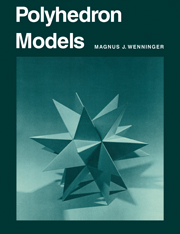Book contents
- Frontmatter
- Dedication
- Contents
- Preface to 1978 reprint
- Preface
- Foreword
- Introduction: uniform polyhedra
- Mathematical classification
- Section I The Convex Uniform Polyhedra: The Platonic and Archimedean Solids
- Section II Some Stellations and Compounds
- Section III Non-convex Uniform Polyhedra
- Epilogue
- References
- List of models
- Frontmatter
- Dedication
- Contents
- Preface to 1978 reprint
- Preface
- Foreword
- Introduction: uniform polyhedra
- Mathematical classification
- Section I The Convex Uniform Polyhedra: The Platonic and Archimedean Solids
- Section II Some Stellations and Compounds
- Section III Non-convex Uniform Polyhedra
- Epilogue
- References
- List of models
Summary
This book has presented only some polyhedral forms. For anyone acquainted with the field there are obvious omissions, the two infinite sets of prisms and antiprisms, all the Archimedean duals (except for the three given on pp. 6-8), and many other polyhedral forms. Among the Archimedean duals two are especially noteworthy, the rhombic dodecahedron and the rhombic triacontahedron. The former is given in Cundy and Rollett along with the stellated forms worked out by Dorman Luke. Stellated forms of the latter are presented in summary fashion without drawings except for the stellation pattern by J. D. Ede in the Mathematical Gazette, XLII (1958). All the Archimedean duals can be stellated, as indeed any polyhedron can. In the light of what you have now learned, you can discover the stellation patterns by yourself, and thus make models of all these polyhedra using the methods and techniques described. So beyond the models presented here, there are more, and more and more! The object of an investigator would not be to multiply forms but to arrive at the underlying mathematical theory that unifies and systematizes whole sets of polyhedral forms.
From this point of view the mathematical investigation takes its origin from an inductive process, akin to the scientific method; namely, to observe individual instances of any phenomenon, then to classify and systematize in order to arrive at general principles which serve as the basis of a deductive process. Many people are not aware of this aspect of mathematics, but the history of mathematics is full of instances bearing this out. (See G. Polya, Mathematics and plausible reasoning.)
So, to end on the same metaphor as that used in the preface, the road still stretches on before you. Why don't you continue your journey?
- Type
- Chapter
- Information
- Polyhedron Models , pp. 204 - 205Publisher: Cambridge University PressPrint publication year: 1971



